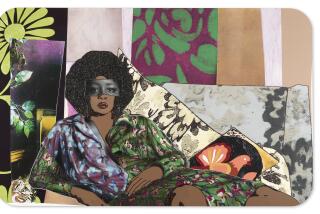Artists Explore Everyday World on Their Own Terms
A white glove with a red cross painted on it at the end of a long cloth-covered stick; large wooden cutouts of the letter R scattered throughout a performance space in which a woman speaks and sings in language seemingly from outer space; a wandering performer whose movements cause strange arrays of shapes and sounds to emit from a homemade audio-visual setup.
What does it all mean? For performance artists Jerry Hunt and Anna Homler, the meaning isn’t important.
“I use an arbitrary language,” explained Hunt, 45, in a telephone conversation from his home in the northeastern Texas town of Canton. “I’m interested in the way people respond to it. I’m not trying to communicate any special meaning. The only sure thing you can say about my work is that it’s definite in its ambiguity.”
Hunt’s work, “Birome (ZONE): Plane,” will be presented tonight as part of the bimonthly Sonic Series at LACE along with songs and stories from Homler’s “Pharmacia Poetica.” Together, it will be an evening of what Hunt refers to as “the byproducts of historical graffiti,” or, in Homler’s words, “psychic archeology.”
More specifically, these artists use their own secret language--Hunt’s more musical and theatrical, Homler’s more lyric and visual--to explore origins of everyday symbols, words, images and objects.
“Any method of doing something is equal to any other way of doing it,” claims Hunt, an ecumenical statement which he adopts as his credo. “It’s up to each individual to choose for themselves what system works best for them.”
A native of Texas, Hunt started his career as a pianist specializing in his own compositions and the music of other American composers. He built his own home in Canton where he enjoys solitude and a frugal life style.
“In 1978, I started performing this way,” Hunt recalled. “It was a radical departure from what I did before. In fact, if I could have been able to hear what I’m doing now before I changed styles, I’m not sure I would have even liked it.
“I guess what got me started was that I got tired of going to concerts and seeing only the working machines of music--the instruments. Not that I like it any better when the instruments are hidden. No, I want things to be seen. But I found it very limiting to sit and watch people playing their instruments.”
Hunt’s homemade rig of computers, samplers and a microwave scanner that picks up his body movement create a theatrical, ritualistic juxtaposition of prerecorded sights and sounds. Stars, sea horses and other random shapes flash on video monitors while consonant chords pulsate, all controlled by the various poses Hunt takes while performing.
“In a way, I really don’t do performance,” continued Hunt. “What I do is a manipulation of the convention of performance. In a very stylized way, I fulfill the expectation of performance, but interact with the audience. I always study the audience and surroundings before I determine exactly what I’m going to do.”
Whereas Hunt’s work utilizes an elaborate setup of electronics and gadgets, Homler’s work uses mostly her voice, exploring the world of language with a unique abstract lyricism. The titles of the songs “Oodi Gae U” and “Karu Karu” are good examples of the language she performs with.
“It’s not English, or any other language,” says Homler, 40, “but people understand it. It’s a primal language that I believe is a part of all languages from all times. It’s where the mundane and extraordinary meet, the junction point of reality. I search for the roots of certain practices and arcane information.”
An anthropology student at UC Berkeley in the late 1960s/early ‘70s, Homler participated in archeological digs including one in Ventura County to find relics left behind by the Chumash Indians. Although there is a strong parallel here to her current activities, Homler makes no connections between her past and present.
“I’ve never been a person who does things from A to B to C , more like from A to L to X to Q and back to A again,” she said. “I’m not one who plans her life down to the detail. I do what seems right at a given point in time and if that’s connected to what I’ve done in the past, that’s OK.”
Although her education and frequent travels to Europe for performances have taken her out of Los Angeles from time to time, Homler has lived in Southern California all her life. She currently resides in Venice.
Traveling also takes up much of Hunt’s time. For him, the trip to Los Angeles is routine, as he has been here several times before.
But he does have one wish: “The smog always goes away when I come to Los Angeles, and I’d kind of like to see it sometime.”
More to Read
The biggest entertainment stories
Get our big stories about Hollywood, film, television, music, arts, culture and more right in your inbox as soon as they publish.
You may occasionally receive promotional content from the Los Angeles Times.










